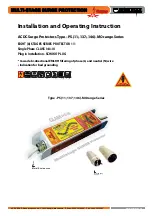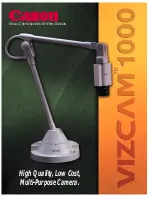
General Information
This device features internal overcurrent and overtemperature
protection that will disconnect affected surge suppression components
at the end of their useful life, but will maintain power to the load –
now unprotected. If this situation is undesirable for the application,
follow these instructions for servicing or replacing the device.
Service of this unit consists of replacing the internal module and/or
display assembly.
There are no user-serviceable parts inside the replaceable module.
Do not attempt to disassemble the module as it stores charge.
Precautionary Statement Regarding SPDs on Ungrounded Systems
Caution – Ungrounded systems are inherently unstable and can
product excessively high line-to-ground voltages during certain fault
conditions. During these fault conditions, any electrical equipment
including an SPD, may be subjected to voltages which exceed their
designed ratings. This information is being provided to the user so
that an informed decision can be made before installing any electrical
equipment on an ungrounded power system.
Overcurrent Protection
The TPS3 SPD unit draws very little current under normal operation and
will only conduct currrent for a very brief duration upon encountering
a transient surge. The TPS3 unit contains overcurrent and thermal
protection to protect against abnormal overvoltage conditions.
System Grounding
An equipment grounding conductor must be used on all electrical
circuits connected to the SPD.
For the best performance, use a single point ground system where
the service entrance grounding electrode system is connected to and
bonded to building steel, metallic piping, driven rods, etc. (NEC and
IEEE Std 142-2007 are appropriate standards).
For sensitive electronics and computer systems, ground impedance
should be as low as possible. When metallic raceway is used as an
additional grounding conductor, an insulated grounding conductor
should be run inside the raceway and sized per the NEC. Adequate
electrical continuity must be maintained at all raceway connections.
Do not use isolating bushings to interrupt a metallic raceway run.
A separate isolated ground for the SPD is NOT recommended because
it may isolate the SPD from the rest of the electrical system, thus
decreasing performance. Proper equipment connections to grounding
system and ground grid continuity should be verified via inspections
and tested on a regular basis as part of a comprehensive electrical
maintenance program.
On 4-Wire Power Systems, neutral to ground bonding (Main Bonding
Jumper) must be installed per the NEC
®
. Failure to do so WILL damage
SPDs.
Environment
The unit is designed to operate inside the equipment in a room ambient
temperature range of: -40
o
C (-40
o
F) to +60
o
C (+140
o
F) with relative
humidity of 0%-95% (non-condensing).
Audible Noise
The SPD’s background noise is negligible which permits installation
within the equipment in almost any room.
Dead front modification Instruction Changes for P1 SPD
Instructions
The TPS3 unit requires a dead front opening to display its face
plate. Remove any installed cover from a dead front opening at the
TPS3 module location. If there is no dead front opening, follow the
instructions in Fig. 2 to create an opening by removing a knockout
plate.
P1 Dead Front Knockout Plate Removal Instructions
Stand the removed dead front on the floor with the plate to be removed
in the upper position, as shown below. Grasping the upper edge of
the dead front, press the cover plate out of the cutout.
Figure 2: Dead Front Modification Instruction
4


































